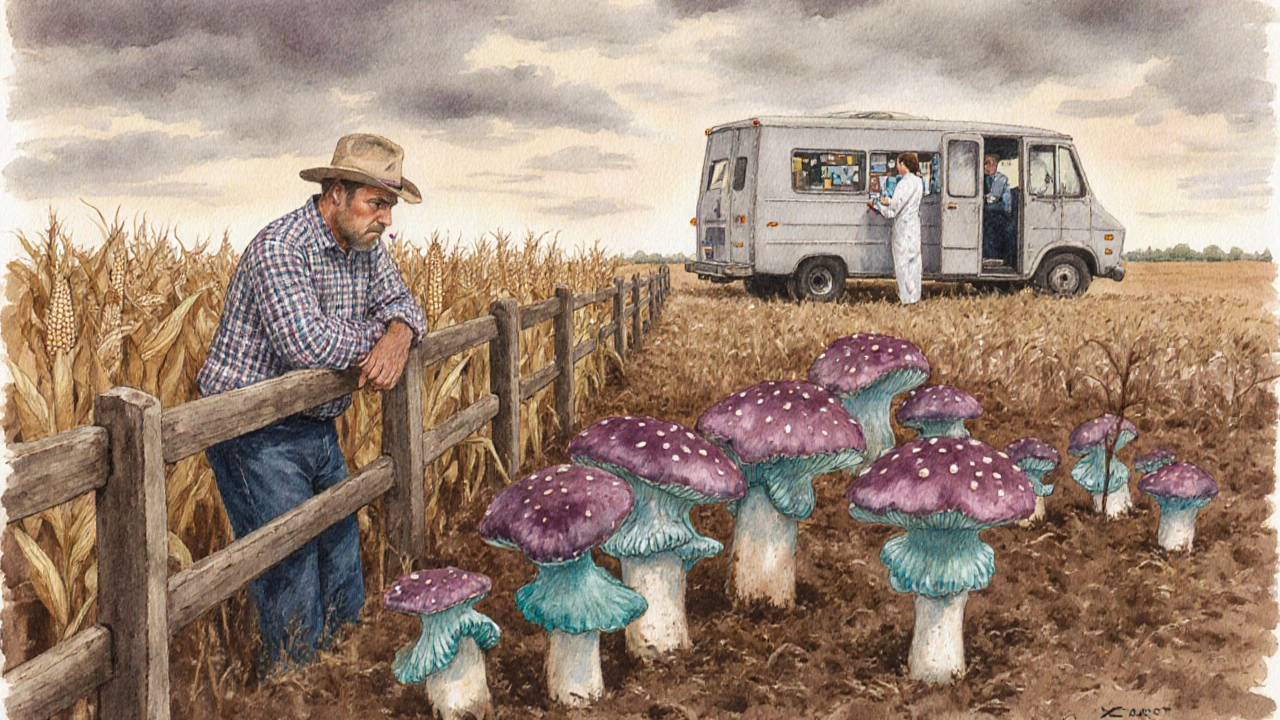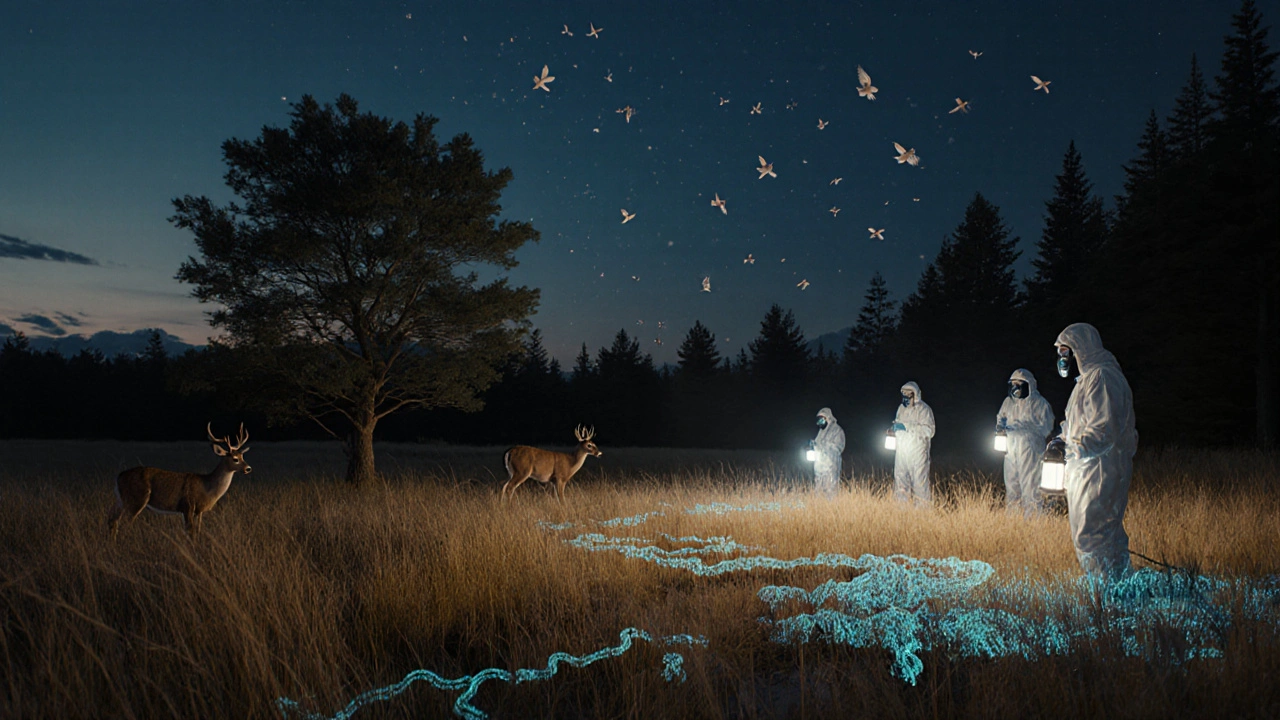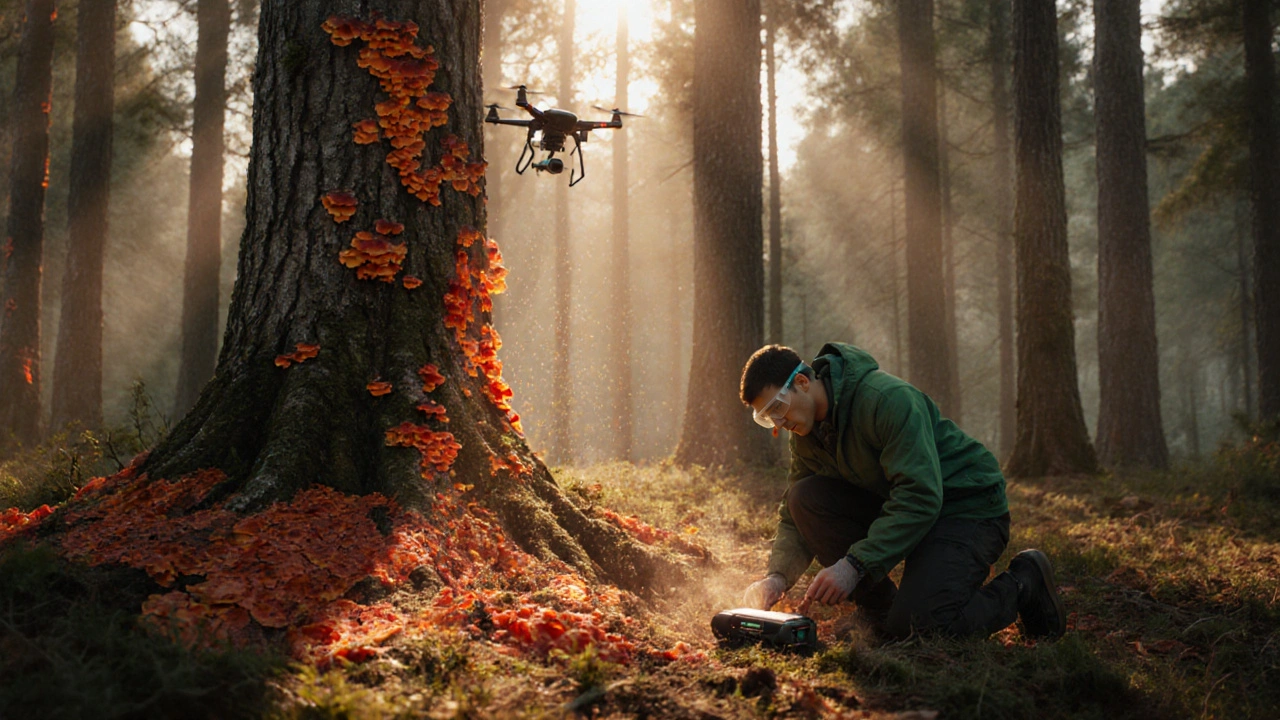Invasive fungi species are non‑native fungal organisms that establish, spread, and cause ecological or economic harm in new regions. They hitch rides on timber, nursery plants, soil, and even tourists' shoes, outcompeting native microbes and destroying host plants or animals. The ripple effects include loss of biodiversity, reduced timber yields, and costly management programs. Below are the five worst offenders and what makes them so hard to control.
Quick Takeaways
- Chestnut blight (Cryphonectria parasitica) wiped out the American chestnut in the early 20th century.
- Dutch elm disease (Ophiostoma novo-ulmi) is still decimating elm populations across Europe and North America.
- Chytrid fungus (Batrachochytrium dendrobatidis) is driving amphibian extinctions worldwide.
- Sudden oak death (Phytophthora ramorum) attacks oaks, tanoaks, and ornamental shrubs.
- Root‑rot fungus (Heterobasidion annosum) degrades coniferous forests and timber quality.
What Makes a Fungus Invasive?
Invasion hinges on three traits: a broad host range, high reproductive output, and efficient dispersal mechanisms. Many of these fungi produce airborne spores that travel hundreds of kilometers, while others survive in soil or water, making eradication a long‑term challenge. Climate change is widening their potential range, giving them new footholds in previously unsuitable habitats.
Cryphonectria parasitica - The Chestnut Blight
Cryphonectria parasitica is a filamentous ascomycete that entered North America on imported Chinese chestnut nursery stock in the early 1900s. Its primary host is Castanea dentata (American chestnut), but it can infect other members of the Fagaceae family. The fungus kills bark tissue by forming a canker that girdles the trunk, leading to rapid tree death.
Impact: Over 3,500km² of chestnut forest vanished, costing the timber industry an estimated US$250million in lost wood and ecosystem services. The loss also disrupted wildlife that relied on chestnut nuts for food.
Control: Biological control using hypovirulent strains (trained with fungal viruses) has slowed spread in Europe, but implementation in the United States remains limited due to regulatory hurdles.
Ophiostoma novo-ulmi - Dutch Elm Disease
Ophiostoma novo-ulmi is a vascular wilt fungus carried by bark beetles (Scolytus multistriatus and S. schevyrewi). Originating in East Asia, it reached Europe in the 1920s and North America in the 1930s.
Impact: More than 30% of the continent’s elm population has been lost; urban landscapes have suffered aesthetically and economically, with municipalities spending billions on replacement plantings.
Control: Sanitation (prompt removal of infected trees) and insecticide treatments of beetle vectors are the most effective tactics. Resistant elm cultivars are being trialed, but they need decades to mature.
Batrachochytrium dendrobatidis - The Chytrid Threat to Amphibians
Batrachochytrium dendrobatidis (Bd) is an aquatic chytrid fungus that infects the keratinized skin of amphibians. First identified in the 1990s, it spread globally via the pet trade and contaminated water sources.
Impact: Over 500 amphibian species are classified as threatened because of Bd, with some populations experiencing >90% mortality. The loss affects food webs, nutrient cycling, and even human health, as amphibians control insect vectors.
Control: Mitigation focuses on biosecurity (disinfecting equipment), captive breeding of vulnerable species, and antifungal treatments like itraconazole baths, though large‑scale field applications remain experimental.
Phytophthora ramorum - Sudden Oak Death
Phytophthora ramorum is an oomycete (often lumped with fungi) that causes lethal cankers on oaks, tanoaks, and many ornamental shrubs. First discovered in the 1990s in California, it quickly spread to the UK, Ireland, and parts of Europe.
Impact: In California alone, >300,000 acres of forest have been compromised, leading to higher fire risk and loss of wildlife habitat. The horticultural trade lost millions in export restrictions.
Control: Eradication relies on strict quarantine, removal of infected plants, and soil drenches with fungicides like phosphorous acid. Early detection via DNA‑based surveillance is crucial.

Heterobasidion annosum - The Conifer Root‑Rot Menace
Heterobasidion annosum is a basidiomycete that attacks the roots of pine, spruce, and fir trees. It spreads through airborne spores and root-to-root contact, thriving in cold, moist soils.
Impact: In Europe, the fungus reduces timber yield by up to 30% and shortens forest rotation periods, costing the wood industry billions annually.
Control: Practices include stump removal after harvest, inoculation with antagonistic fungi (e.g., Trichoderma harzianum), and planting of less‑susceptible species. Chemical protectants are effective but regulated due to environmental concerns.
Side‑by‑Side Comparison
| Fungus | Origin | Primary Hosts | Spread Mechanism | Economic/Environmental Impact |
|---|---|---|---|---|
| Cryphonectria parasitica | East Asia | American chestnut, other Fagaceae | Airborne spores, infected nursery stock | US$250M loss, forest ecosystem collapse |
| Ophiostoma novo-ulmi | East Asia | Elm species (Ulmus spp.) | Beetle vectors (Scolytus spp.) | Billions in urban tree replacement |
| Batrachochytrium dendrobatidis | Likely Africa/Asia | Amphibians (frogs, salamanders) | Waterborne zoospores, pet trade | 500+ threatened species, ecosystem disruption |
| Phytophthora ramorum | Western North America | Oak, tanoak, Rhododendron, Camellia | Rain splash, contaminated plant material | 300,000+ acres damaged, fire‑risk increase |
| Heterobasidion annosum | Europe/Northern Asia | Pine, spruce, fir | Airborne spores, root contact | 30% timber loss, multimillion‑dollar economic hit |
How Invasive Fungi Travel Around the Globe
Global trade is the main highway. Wood packaging material, live plant shipments, and even soil adhering to equipment act as carriers. In the case of invasive fungi, a single contaminated pallet can seed an entire region. Climate‑controlled warehouses further boost survival odds, allowing spores to remain viable during long voyages.
Human recreation also contributes. Hikers unintentionally transport soil on boots, spreading root‑rot pathogens into pristine mountain forests. It's why many national parks now require shoe‑cleaning stations.
Management Strategies That Work
Successful control mixes prevention, early detection, and targeted response.
- Quarantine and Inspection: Agencies like the IPPC (International Plant Protection Convention) enforce strict phytosanitary standards for timber imports.
- Surveillance Networks: DNA‑based traps and citizen‑science apps flag new outbreaks before they explode.
- Biological Controls: Hypovirulent strains (for chestnut blight) and antagonistic fungi (for root‑rot) provide sustainable weapons.
- Silvicultural Practices: Removing infected stumps, diversifying tree species, and maintaining healthy canopy cover reduce vulnerability.
Funding remains a hurdle; many governments allocate only a fraction of their forestry budgets to invasive‑species monitoring. Private‑sector partnerships are emerging as a way to fill the gap.
Related Topics Worth Exploring
To deepen your understanding, consider reading about:
- Risk assessment models for plant pathogens.
- Climate‑change projections and their effect on fungal range expansion.
- Regulatory frameworks: USDA‑APHIS, EU Plant Health Regulations.
- Success stories: The reintroduction of disease‑resistant American chestnut hybrids.
- Citizen‑science platforms like iNaturalist used for fungal surveillance.
Next Steps for Landowners and Citizens
If you manage a forest, orchard, or garden, start with a simple checklist:
- Inspect new plant material for signs of discoloration, cankers, or wilting.
- Sanitize tools and footwear before entering new sites.
- Report suspicious die‑back to local extension services.
- Consider planting a mix of native, disease‑resistant species.
- Stay updated on regional quarantine alerts through government websites.
Even small actions add up, slowing the march of these silent invaders.

Frequently Asked Questions
What defines an invasive fungus?
An invasive fungus is a non‑native fungal organism that establishes, spreads rapidly, and causes measurable ecological or economic damage in a new region.
How can I tell if my trees are infected?
Look for symptoms such as cankers on bark, sudden crown die‑back, resin exudation, or unusual leaf spotting. In many cases, a lab test of tissue samples confirms the pathogen.
Are there chemical treatments that work?
Certain fungicides, like phosphorous acid for Phytophthora ramorum or systemic triazoles for root‑rot, can curb spread when applied correctly. However, over‑reliance leads to resistance, so integration with cultural and biological controls is recommended.
Can invasive fungi affect humans?
Direct health impacts are rare, but indirect effects-like loss of forest‑cover that buffers floods or reduces air quality-can harm human communities. Some fungi produce mycotoxins that contaminate crops, posing food‑safety concerns.
What role does climate change play?
Warmer temperatures and altered precipitation patterns expand suitable habitats for many fungi, allowing them to survive in regions previously too cold or dry. This accelerates the rate of new invasions worldwide.
How do governments monitor invasive fungi?
Agencies use a mix of border inspections, sentinel plantings, DNA‑based detection kits, and reporting networks involving scientists, foresters, and the public. Funding and coordination vary by country, but international treaties like the IPPC provide a common framework.
Are there any success stories?
Yes. In parts of Europe, the introduction of a hypovirulent strain of Cryphonectria parasitica has reduced chestnut blight mortality by up to 70%. Similarly, resistant elm cultivars have begun to repopulate urban streets in the UK.

Those fungi spread faster than gossip at a tavern